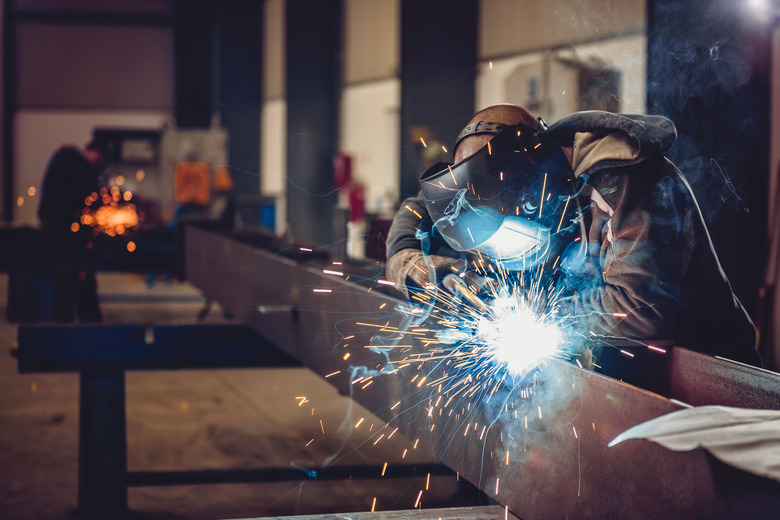List Of The Basic Equipment For Welding
To get started in the basics of welding, you need a welder, electrodes, feeds and safety gear. But before you start, it might be a good idea to take a class or find an expert who can teach you how to weld. If you fail to learn the basic safety requirements, you can seriously burn yourself or damage your eyes. The process of welding joins metal together by melting two pieces of metal at a seam and creating a joint.
TL;DR (Too Long; Didn't Read)
Wire feeds make welding much easier than it used to be. Cleaning the metal to be welded with a degreaser, helps to make the weld stronger. If you grind or file a bevel along edges you plan to weld, it helps the liquid metal penetrate deeply into the joint. Clean up welds by lightly grinding or filing them, but don't overdo it as you could break the weld.
TIG and MIG Welders
TIG and MIG Welders
The most common welder used in basic projects by homeowners and hobbyists is the stick welder. Also known as the shielded-metal arc welder, most people prefer it due to how easy it is to buy and the lack of a special environment needed to use it. But the electrodes in a stick welder require frequent replacement compared with other forms of welding. These include the gas tungsten arc machines, TIG and gas metal arc welder, known as MIG welders. You will also need some sort of gas feed with this type of welder.
Charged Electrode
Charged Electrode
An electrode is the tip of the tool that passes the current from the welder to the material being welded, making it so hot it becomes liquid. In the cases of the stick and MIG welders, the type of metal and the heat to melt it drives the type of electrode tip needed. But in a TIG welder, the electrode tip is made of non-consumable tungsten, and does not require replacement.
Wire and Electrode Feeds
Wire and Electrode Feeds
Some welds require a feed to strengthen the joint due to the geometry or weakness of the weld. Stick welding uses the electrode to feed; MIG welding often uses a wire feed. And TIG welding likewise uses a feed due to its non-consumable nature.
Other Tools
Other Tools
Most welders also use an angle grinder to help smooth out joints, wire brushes, to clean metal surfaces or abrade them before welding, a chipping slag hammer, C-clamps, ball peen hammer, electrode tip cleaners, flint strikers, needle nose and linesmen cutting pliers. Other tools to have on hand: cold chisels, flat-head and Phillips screwdrivers, round and flat files, levels and squares.
Safety Equipment
Safety Equipment
Due to the temperature and elements involved, welding is highly dangerous and can be lethal if handled incorrectly. Before you touch a welding setup, wear a welding helmet that protects your eyes, ear plugs, solid boots to protect your feet from sparks or slag, welding gloves to protect your hands and leathers to cover the rest of your body. Do not weld without these, as you will likely get hurt.
Cite This Article
MLA
Campbell, Colin. "List Of The Basic Equipment For Welding" sciencing.com, https://www.sciencing.com/list-basic-equipment-welding-7831779/. 25 April 2018.
APA
Campbell, Colin. (2018, April 25). List Of The Basic Equipment For Welding. sciencing.com. Retrieved from https://www.sciencing.com/list-basic-equipment-welding-7831779/
Chicago
Campbell, Colin. List Of The Basic Equipment For Welding last modified March 24, 2022. https://www.sciencing.com/list-basic-equipment-welding-7831779/
